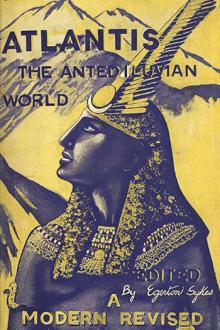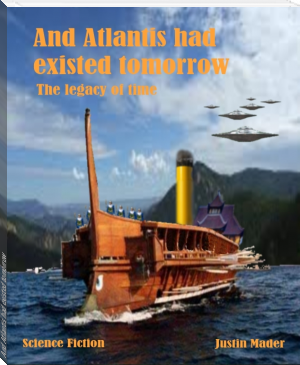Atlantis: The Antedeluvian World by Ignatius Donnelly (thriller novels to read .TXT) 📕

- Author: Ignatius Donnelly
- Performer: -
Book online «Atlantis: The Antedeluvian World by Ignatius Donnelly (thriller novels to read .TXT) 📕». Author Ignatius Donnelly
Professor Wilson describes the hair of the ancient Peruvians, as found upon their mummies, as “a lightish brown, and of a fineness of texture which equals that of the Anglo-Saxon race.” “The ancient Peruvians,”
says Short (“North Americans of Antiquity,” p. 187), “appear, from numerous examples of hair found in their tombs, to have been an auburn-haired race.” Garcilasso, who had an opportunity of seeing the body of the king, Viracocha, describes the hair of that monarch as snow-white. Haywood tells us of the discovery, at the beginning of this century, of three mummies in a cave on the south side of the Cumberland River (Tennessee), who were buried in baskets, as the Peruvians were occasionally buried, and whose skin was fair and white, and their hair auburn, and of a fine texture. (“Natural and Aboriginal History of Tennessee,” p. 191.)
CHOCTAW.Neither is the common opinion correct which asserts all the American Indians to be of the same type of features. The portraits on this page and on pages 187 and 191, taken from the “Report of the U. S. Survey for a Route for a Pacific Railroad,” present features very much like those of Europeans; in fact, every face here could be precisely matched among the inhabitants of the southern part of the old continent.
SHAWNEES.On the other hand, look at the portrait of the great Italian orator and reformer, Savonarola, on page 193. It looks more like the hunting Indians of North-western America than any of the preceding faces. In fact, if it was dressed with a scalp-lock it would pass muster anywhere as a portrait of the “Man-afraid-of-his-horses,” or “Sitting Bull.”
SAVONAROLA.Adam was, it appears, a red man. Winchell tells us that Adam is derived from the red earth. The radical letters ÂDâM are found in ADaMaH, “something out of which vegetation was made to germinate,” to wit, the earth. ÂDôM and ÂDOM signifies red, ruddy, bay-colored, as of a horse, the color of a red heifer. “ÂDâM, a man, a human being, male or female, red, ruddy.” (“Preadamites,” p.161.)
“The Arabs distinguished mankind into two races, one red, ruddy, the other black.” (Ibid.) They classed themselves among the red men.
Not only was Adam a red man, but there is evidence that, from the highest antiquity, red was a sacred color; the gods of the ancients were always painted red. The Wisdom of Solomon refers to this custom: “The carpenter carved it elegantly, and formed it by the skill of his understanding, and fashioned it to the shape of a man, or made it like some vile beast, laying it over with vermilion, and with paint, coloring it red, and covering every spot therein.”
The idols of the Indians were also painted red, and red was the religious color. (Lynd’s MS. “Hist. of Dakotas,” Library, Hist. Society, Minn.)
The Cushites and Ethiopians, early branches of the Atlantean stock, took their name from their “sunburnt” complexion; they were red men.
The name of the Phœnicians signified red. Himyar, the prefix of the Himyaritic Arabians, also means red, and the Arabs were painted red on the Egyptian monuments.
The ancient Egyptians were red men. They recognized four races of men—the red, yellow, black, and white men. They themselves belonged to the “Rot,” or red men; the yellow men they called “Namu”—it included the Asiatic races; the black men were called “Nahsu,” and the white men “Tamhu.” The following figures are copied from Nott and Gliddon’s “Types of Mankind,” p. 85, and were taken by them from the great works of Belzoni, Champollion, and Lepsius.
In later ages so desirous were the Egyptians of preserving, the aristocratic distinction of the color of their skin, that they represented themselves on the monuments as of a crimson hue—an exaggeration of their original race complexion.
In the same way we find that the ancient Aryan writings divided mankind into four races—the white, red, yellow, and black: the four castes of India were founded upon these distinctions in color; in fact, the word for color in Sanscrit (varna) means caste. The red men, according to the Mahâbhârata, were the Kshatriyas—the warrior caste-who were afterward engaged in a fierce contest with the whites—the Brahmans—and were nearly exterminated, although some of them survived, and from their stock Buddha was born. So that not only the Mohammedan and Christian but the Buddhistic religion seem to be derived from branches of the Hamitic or red stock. The great Manu was also of the red race.
THE RACES OF MEN ACCORDING TO THE EGYPTIANS.The Egyptians, while they painted themselves red-brown, represented the nations of Palestine as yellow-brown, and the Libyans yellow-white. The present inhabitants of Egypt range from a yellow color in the north parts to a deep bronze. Tylor is of opinion (“Anthropology,” p. 95) that the ancient Egyptians belonged to a brown race, which embraced the Nubian tribes and, to some extent, the Berbers of Algiers and Tunis. He groups the Assyrians, Phœnicians, Persians, Greeks, Romans, Andalusians, Bretons, dark Welshmen, and people of the Caucasus into one body, and designates them as “dark whites.” The Himyarite Arabs, as I have shown, derived their name originally from their red color, and they were constantly depicted on the Egyptian monuments as red or light brown.
Herodotus tells us that there was a nation of Libyans, called the Maxyans, who claimed descent from the people of Troy (the walls of Troy, we shall see, were built by Poseidon; that is to say, Troy was an Atlantean colony). These Maxyans painted their whole bodies red. The Zavecians, the ancestors of the Zuavas of Algiers (the tribe that gave their name to the French Zouaves), also painted themselves red. Some of the Ethiopians were “copper-colored.” (“‘Amer. Cyclop.,” art. Egypt, p.
464.) Tylor says (“Anthropology,” p. 160): “The language of the ancient Egyptians, though it cannot be classed in the Semitic family with Hebrew, has important points of correspondence, whether due to the long intercourse between the two races in Egypt or to some deeper ancestral connection; and such analogies also appear in the Berber languages of North Africa.”
These last were called by the ancients the Atlanteans.
“If a congregation of twelve representatives from Malacca, China, Japan, Mongolia, Sandwich Islands, Chili, Peru, Brazil, Chickasaws, Comanches, etc., were dressed alike, or undressed and unshaven, the most skilful anatomist could not, from their appearance, separate them.” (Fontaine’s “How the World was Peopled,” pp. 147, 244.) Ferdinand Columbus, in his relation of his father’s voyages, compares the inhabitants of Guanaani to the Canary Islanders (an Atlantean race), and describes the inhabitants of San Domingo as still more beautiful and fair. In Peru the Charanzanis, studied by M. Angraud, also resemble the Canary Islanders. L’Abbé Brasseur de Bourbourg imagined himself surrounded by Arabs when all his Indians of Rabinal were around him; for they had, he said, their complexion, features, and beard. Pierre Martyr speaks of the Indians of the Parian Gulf as having fair hair. (“The Human Species,” p. 201.) The same author believes that tribes belonging to the Semitic type are also found in America. He refers to “certain traditions of Guiana, and the use in the country of a weapon entirely characteristic of the ancient Canary Islanders.”
When science is able to disabuse itself of the Mortonian theory that the aborigines of America are all red men, and all belong to one race, we may hope that the confluence upon the continent of widely different races from different countries may come to be recognized and intelligently studied. There can be no doubt that red, white, black, and yellow men have united to form the original population of America. And there can be as little doubt that the entire population of Europe and the south shore of the Mediterranean is a mongrel race—a combination, in varying proportions, of a dark-brown or red race with a white race; the characteristics of the different nations depending upon the proportions in which the dark and light races are mingled, for peculiar mental and moral characteristics go with these complexions. The red-haired people are a distinct variety of the white stock; there were once whole tribes and nations with this color of hair; their blood is now intermingled with all the races of men, from Palestine to Iceland.
Everything in Europe speaks of vast periods of time and long. continued and constant interfusion of bloods, until there is not a fair-skinned man on the Continent that has not the blood of the dark-haired race in his veins; nor scarcely a dark-skinned man that is not lighter in hue from intermixture with the white stock.
CHAPTER VI.
GENESIS CONTAINS A HISTORY OF ATLANTIS
The Hebrews are a branch of the great family of which that powerful commercial race, the Phœnicians, who were the merchants of the world fifteen hundred years before the time of Christ, were a part. The Hebrews carried out from the common storehouse of their race a mass of traditions, many of which have come down-to us in that oldest and most venerable of human compositions, the Book of Genesis. I have shown that the story of the Deluge plainly refers to the destruction of Atlantis, and that it agrees in many important particulars with the account given by Plato. The people destroyed were, in both instances, the ancient race that had created civilization; they had formerly been in a happy and sinless condition; they had become great and wicked; they were destroyed for their sins—they were destroyed by water.
But we can go farther, and it can be asserted that there is scarcely a prominent fact in the opening chapters of the Book of Genesis that cannot be duplicated from the legends of the American nations, and scarcely a custom known to the Jews that does not find its counterpart among the people of the New World.
Even in the history of the Creation we find these similarities: The Bible tells us (Gen. i., 2) that in the beginning the earth was without form and void, and covered with water. In the Quiche legends we are told, “at first all was sea—no man, animal, bird, or green herb—there was nothing to be seen but the sea and the heavens.”
The Bible says (Gen. i., 2), “And the Spirit of God moved upon the face of the waters.” The Quiche legend says, “The Creator—the Former, the Dominator—the feathered serpent—those that give life, moved upon the waters like a glowing light.”
The Bible says (Gen. i., 9), “And God said, Let the waters under the heaven be gathered together unto one place, and let the dry land appear: and it was so.” The Quiche legend says, “The creative spirits cried out ‘Earth!’ and in an instant it was formed, and rose like a vapor-cloud; immediately the plains and the mountains arose, and the cypress and pine appeared.”
The Bible tells us, “And God saw that it was good.” The Quiche legend says, “Then Gucumatz was filled with joy, and cried out, ‘Blessed be thy coming, O Heart of Heaven, Hurakan, thunder-bolt.’”
The order in which the vegetables, animals, and man were formed is the same in both records.
In Genesis (chap. ii., 7) we are told, “And the





Comments (0)